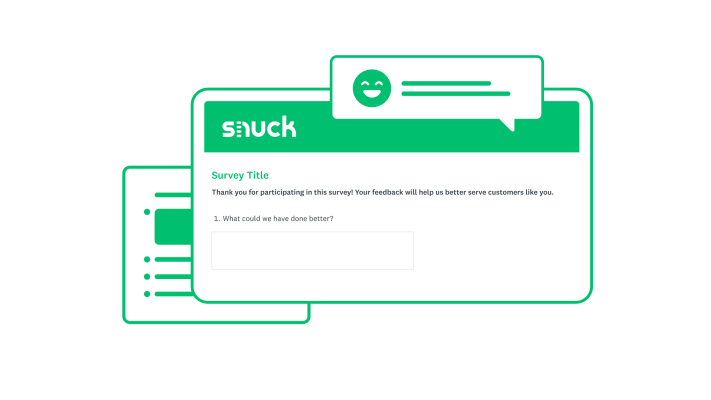10 tips for building stellar NPS surveys
Learn how to create effective Net Promoter Score (NPS) surveys that capture insightful feedback and improve your customer satisfaction and loyalty.

What are NPS surveys?
Net Promoter Score (NPS®) surveys are a cornerstone of customer feedback. They revolve around a single question: “On a scale of 0 to 10, how likely is it that you would recommend us to a friend or colleague?” While the NPS question may be deceptively simple, it has the power to give your company rich and valuable insights into customer loyalty and satisfaction.
There are a few different types of NPS surveys that you can leverage in different ways to achieve your goals. For example, NPS surveys can request feedback from customers about your business as a whole, which is sometimes referred to as relational NPS or rNPS. NPS surveys can also be used to request feedback about a specific interaction or transaction, such as visiting your website, making a purchase or submitting a support ticket. These are examples of transactional NPS surveys, or tNPS.
Many organisations use a combination of both relational and transactional NPS surveys to gain insight into the customer experience and make smart decisions to improve the customer journey across every touchpoint.
Creating better NPS surveys
Even though NPS surveys are simple by design, it’s still very important to take a strategic approach to make sure you’re getting the most out of this valuable feedback channel. Here are 10 tips to help you improve the effectiveness of your NPS surveys and capture the insights you need to improve your business.
1. Set clear goals
Define specific objectives for each survey
Always start by establishing clear, measurable objectives for your NPS survey. This step is crucial as it directly influences the questions that you ask and the audience that you target. For example, if your goal is to evaluate customer satisfaction with a recent software update, your survey should be tailored to gather feedback specifically about that update.
Tie your objectives to the broader business goals
The goals of your NPS survey should also be aligned with your organisation’s broader business objectives. This alignment helps to ensure that the insights you extract from your NPS surveys are relevant and actionable. If you have an organisational goal around long-term customer retention, for example, focus your NPS surveys on aspects of your customer experience that contribute to ongoing loyalty.
Identify key performance indicators (KPIs)
Decide which metrics you’ll use to assess the success of your NPS surveys. Beyond the NPS itself, consider tracking metrics such as survey response rates, the customer churn rate or repeat purchases. These metrics can offer a more holistic and nuanced understanding of customer sentiment and behaviour.
Segment your audience
Segmenting your audience enhances the power of NPS surveys. While surveying your entire customer base provides valuable insights into overall satisfaction, breaking down responses by specific segments unlocks more actionable data. For instance, comparing feedback from recent customers against long-standing clients may reveal critical differences in terms of perception and needs. This targeted approach allows you to tailor strategies for different customer groups, ultimately driving more effective improvements in your products or services.
2. Keep NPS surveys simple and focused
Your customers’ time is valuable and a survey that takes too long to complete will adversely affect your response rates. Here are a few tips on how to keep your NPS surveys brief and easy to complete:
Limit the number of questions
The strength of an NPS survey lies in its simplicity. Although follow-up questions can add more detail and colour to your NPS responses, don’t get carried away! Limit your NPS surveys to just a few essential questions to maximise your response rate.
After the primary NPS question, include just one or two follow-up questions that probe into the reasons behind the score. This approach allows you to gather qualitative data without overburdening the respondents. The standard open-ended NPS question is “What is the primary reason for your score?” However, you can certainly modify this question to meet your needs.
Focus on actionable questions
Follow-up questions should be designed to prompt customers to give you feedback that you can actually act on. Instead of vague or generic questions, ask for specific feedback that will guide improvements in your product, service or customer experience.
For example, consider asking follow-up questions such as:
- What is one thing we could do to make you happier?
- What was missing in your experience with us?
- Which features of the product did you like best/least?
Ensure clarity and relevance
Clarity is key in NPS surveys. Keep questions concise and directly aligned with your objectives, using language that’s accessible to all customers. For example, instead of asking "How would you rate the user interface of our SaaS platform?" try "How easy is our software to use?" This approach not only boosts participation rates but also ensures more reliable data.
3. Choose the right timing and frequency
Choosing the right timing and frequency for your NPS survey is crucial to maintaining high completion rates and obtaining high-quality data. Transactional NPS surveys aim to capture feedback while the customer’s experience with your brand is still fresh. Meanwhile, conducting regular NPS surveys at well-spaced intervals allows you to track changes over time without overwhelming respondents. This balanced approach enables you to create a cycle of continuous improvement based on timely, relevant feedback.
Timing is everything
For transactional NPS surveys, the ideal time to send out a survey is shortly after a customer interaction or experience with your product or service. Whether it’s post-purchase, following a support call or after using a specific feature, prompt surveying ensures that the experience remains vivid in the customer’s mind. This immediacy leads to more accurate and detailed feedback, providing you with actionable insights to enhance your offerings and customer experience.
Avoid survey fatigue
Finding the right survey frequency is key to maintaining quality feedback without overwhelming your customers. While regular input is valuable, too many surveys can lead to fatigue and lower response rates. Consider your product or service type, customer interaction frequency and industry norms when setting your schedule. For many businesses, a quarterly approach works well, but you should adjust this as needed to suit your specific situation.
Monitor and adjust based on response trends
An intentional survey cadence with intervals gives you time to implement meaningful changes based on previous feedback as well as for customers to experience these improvements. Make sure you keep a close eye on response trends and feedback quality. If response rates drop or feedback becomes less insightful, it might mean that you’re sending too many surveys or sending them at the wrong time. Monitor and adjust your frequency or distribution strategy accordingly.
4. Add your branding
Incorporate your company’s fonts, colours and logo into the survey. This not only helps reinforce your brand recognition but also instils a sense of professionalism and trustworthiness in the survey process.
Send surveys from your domain
Make sure your NPS surveys come from your domain instead of a generic one (e.g. person@yourcompany.com vs. person@outlook.com). This adds authenticity to your email, improves delivery and open rates and builds trust with your recipients. It also decreases the likelihood of your surveys being flagged as spam.
Balance branding elements with clarity and simplicity
While branding is important, it should not overshadow your survey’s content. Use colours, logos and fonts that reflect your brand without distracting from or complicating the survey experience. Your primary goal should still be to make the survey easy to read, understand and complete.
Optimise for different devices
Make sure that your branded survey is optimised for all devices, including desktops, tablets and smartphones. This makes it easy for your customers to share their feedback from wherever is most convenient for them. Ensure that your survey design and branding elements render correctly and remain functional across all platforms.
5. Personalise your NPS survey
Address the customer by name
People are more likely to open an email and respond to a survey when they feel a personal connection. When sending out your surveys, incorporate email personalisation, including using your recipient’s first name, to make the communication more individual and engaging.
Mention recent interactions
Personalising your NPS survey to reflect the customer’s latest engagement with your brand can significantly boost response rates and provide more relevant feedback. When crafting your survey invitation, explicitly mention the recent interaction to jog the customer’s memory and emphasise the survey’s relevance. For example, if sending a survey after a purchase, your email might begin with: "We hope you’re enjoying your new [product name]." This context not only increases the likelihood of engagement but also primes the customer to provide more specific, actionable feedback.
Customise follow-up questions
Enhance the depth of your NPS insights by tailoring open-ended questions to each respondent’s rating. Utilising sophisticated skip logic allows you to gather more nuanced feedback.
For detractors and passives (those scoring 8 or below), probe into areas for improvement, asking specific questions about their experiences and expectations. Conversely, engage promoters (those selecting 9 or 10) by inviting them to elaborate on what they find most compelling about your product or company. This targeted approach not only yields more actionable feedback but also demonstrates to customers that you value their individual perspectives, potentially boosting engagement and response quality across all satisfaction levels.
6. Test your NPS survey prior to sending it
Pilot-testing your survey with a small group is a crucial step in refining your NPS strategy. This practice helps you identify any potential issues, ensures that the questions are clear and effectively structured and allows you to gauge the overall user experience before deploying the survey to a broader audience.
Additionally, this preliminary testing phase provides an opportunity to assess whether the survey is capturing the specific insights that you’re seeking, enabling you to make data-driven adjustments that can significantly improve the quality and actionability of your feedback.
Assess question clarity
The pilot test is important for assessing question clarity and respondent interpretation. Pay close attention to how participants understand key terms and concepts, noting any items that cause confusion or misinterpretation, to ensure that your final survey captures accurate, actionable insights across your entire customer base.
Evaluate time to complete
It’s also helpful to know how long it takes to complete the survey. If it’s too long, respondents might lose interest and abandon the survey without finishing it. With a pilot test, you can see how long it took your test group to answer your survey and adjust the survey length if necessary.
Refine the survey accordingly
Use the insights gathered from your pilot test to refine your survey. This may involve rephrasing ambiguous questions, adjusting their order for better logical flow or modifying the balance between closed and open-ended questions to optimise response quality and completion rates.
7. Add an open-ended question
Incorporating open-ended questions into your NPS surveys is crucial for gathering rich, actionable insights. These qualitative responses provide context for numerical ratings, revealing underlying issues and unexpected delights that scales alone can’t capture. By encouraging more open expression, you’ll uncover trends and improvement opportunities, thus enabling targeted enhancements that directly address customer needs and preferences.

Capture rich, qualitative data
Open-ended questions help you understand the “why” behind NPS. Unlike rating scales, open-ended questions allow customers to articulate their thoughts in their own words. This provides a wealth of qualitative data, giving you a more comprehensive view of your customers’ experiences and perceptions.
Create a dialogue with customers
You can also use open-ended questions to signal to customers that you value their detailed feedback and are willing to listen. This can foster a sense of engagement and loyalty, as customers feel that their opinions are being heard and considered.
8. Act on NPS feedback
Analysing NPS survey results is a critical step that transforms raw data into actionable insights. Go beyond merely calculating your overall NPS score: segment your results by customer demographics, product lines or touchpoints to uncover nuanced patterns. Below, we’ll explain how to interpret the scores and comments to identify trends, understand customer needs and make informed improvements to your business.
Identify trends and patterns
To uncover meaningful insights, integrate your quantitative NPS scores with qualitative feedback. This holistic approach reveals the root causes behind customer satisfaction levels. Look for correlations between NPS and other key performance indicators such as customer lifetime value (CLV) or churn rate. Alternatively, you can use text analysis tools to extract common themes from open-ended responses. These deeper insights will guide targeted improvements, helping you prioritise initiatives that will have the most significant impact on customer loyalty and business growth.
Prioritise improvements
Transform your NPS insights into a strategic action plan by prioritising improvements that will have the greatest impact on customer satisfaction and loyalty. Evaluate feedback themes according to factors such as frequency of mention, severity of impact and alignment with business goals.
Measure the impact
After implementing changes, measure their impact on customer satisfaction and loyalty. For example, conduct follow-up NPS surveys to see whether scores have improved and to get feedback on the changes you made. By regularly tracking progress and adjusting your strategy as needed, you’ll create a dynamic cycle of continuous improvement driven by customer feedback.
9. Follow up on open-ended feedback
If a respondent takes the time to provide detailed feedback, it’s a great idea to acknowledge it and continue the conversation. Personalised follow-up on their comments shows that you value their input and are committed to improving.
Here are a few tips on how to follow up effectively with open-ended NPS questions:
Ask for clarification
If the feedback is unclear or you need more details in order to take action, contact the customer for further clarification. Your message should be respectful and convey the fact that you want to gain a better understanding of their perspective. Here’s an example of how to follow up and obtain more details from a detractor:
“Thanks for responding to our NPS survey. We’re sorry to hear that you wouldn’t recommend us and we’d love an opportunity to learn more about what we could do to improve. What could we be doing better?”
Address specific concerns
If the feedback includes specific concerns or issues, address them directly. Share any details about how these issues are being handled or your plans to address them. If immediate resolution isn’t possible, explain the steps being taken to find a solution. And don’t forget to follow up again once the issue has been resolved.
Invite ongoing dialogue
Encourage ongoing communication. Let customers know that their input is always welcome and valued. Offer channels for them to provide further feedback or keep up to date with changes and improvements.
Encourage customer advocacy
If the feedback is exceptionally positive, consider inviting the respondent to participate in a case study, provide a testimonial or become a brand advocate. For example, consider asking NPS promoters to share their experience on social media or to review your business on the channels that are important to you.
Learn more about how to follow up with NPS promoters, passives and detractors.
10. Sustain continuous improvement
Transform NPS insights into ongoing enhancements by establishing a systematic approach to acting on feedback. Integrate NPS insights into your operational processes by reviewing findings regularly, sharing improvements with customers and equipping teams with current data.
This approach allows for informed decision-making and enables proactive issue resolution, while tracking outcomes helps measure the effectiveness of your improvements. By consistently applying these practices, you’ll create a dynamic cycle of improvement that adapts to evolving customer needs, enhancing satisfaction and loyalty over time.
Start building stellar NPS surveys today
Well-structured NPS surveys are a powerful tool for improving customer satisfaction and loyalty. Remember, NPS is more than just a questionnaire: it’s a bridge connecting customer feedback to actions that drive meaningful improvement.
Get started with our free NPS survey template.
Net Promoter, Net Promoter Score and NPS are registered trademarks of Bain & Company, Inc., Satmetrix Systems, Inc. and Fred Reichheld.
Discover more resources

Customer satisfaction survey templates
Explore our customer satisfaction survey templates to rapidly collect data, identify pain points and improve your customer experience.

See how Ryanair collects customer insights at scale
Discover how Ryanair uses SurveyMonkey and its Microsoft Power BI integration to track 500k monthly CSAT surveys and improve customer experiences.

How to identify customer needs
Refine your market research approach with our guide to identifying customer needs and what UK shoppers are looking for in 2024.

See how woom enhances its employee and customer experience
Discover how woom uses SurveyMonkey to launch multilingual surveys at scale, improve the employee experience and capture customer insights.